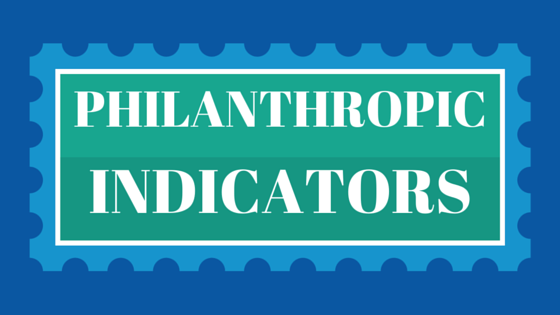It’s crucial that nonprofits place measured emphasis on every stage of the major gift process. From identification to cultivation to solicitation to stewardship, each phase hinges on a nonprofit’s ability to connect with their donors and draw them to donate. That ability should be rooted in a researched knowledge of the donors. The better you know your donors, the better equipped you’ll be to curate the perfect major gifts strategy.
Take, for instance, capital campaigns. During a capital campaign, a large portion of your funds will come from major gifts acquired during the quiet phase. Quiet phase success can prove pivotal, so it’s highly important that your team identifies the top prospects and implements an informed strategy to solicit them.
Effective prospect identification can, therefore, be make or break for a capital campaign. So, whether you’re pursuing major gifts for something as specific as a capital campaign or you’re looking for upgrade candidates amongst your annual fund donors, prospect research should always be part of the discussion.
Effective prospect identification can, therefore, be make or break for a capital campaign.
Before you send your gift officers out to start building donor relationships, make sure your team is prepared with the best list of prospects possible.
- Have they given to your organization?
- Have they donated elsewhere?
- Are they involved in nonprofit work?
- What real estate do they own?
- What about their stock ownership?
- Have they made donations to political campaigns?
- What are their business affiliations?
To make the list easier to digest, we’ve actually segmented it out according to two categories.

- Philanthropic Indicators: Past Giving to Your Nonprofit, Previous Donations to Other Nonprofits, and Nonprofit Involvement
- Wealth-Related Indicators: Real Estate Ownership, Stock Ownership, Political Giving, Business Affiliations
Let’s delve into the benefits of studying each of these traits!
Philanthropic Indicators
The most effective prospect research leads with philanthropy. After all, the wealthiest person in the world won’t necessarily be interested in giving, but someone with tighter financial constraints who is dedicated to charitable work is likely to be more willing to give.
This is where the discussion of affinity versus capacity enters the equation.
- Affinity, or warmth toward your organization, is judged based on philanthropic traits.
- Capacity, or financial ability to make a donation, is judged based on wealth traits.
While both are necessary to get an accurate picture of a prospect’s likelihood of giving major gifts, you should lead your research with the affinity side of the equation.
That’s why we’re starting with philanthropic indicators here!
For more on the process behind uncovering these traits, look into this resource on prospect research: https://doublethedonation.com/prospect-research/

#1: Have they given to your organization?
Past giving to your nonprofit is the most authoritative indicator out there.
Nothing predicts future giving better than past giving. And if the past gift happens to be major (or even close to it), that only magnifies the correlation.
If you stop to think about it, this makes perfect sense. Who better to look to for gifts than those who have already demonstrated a willingness to give to your cause? Make sure you’re bringing your donor retention A-game!
Donor retention should always be a priority, but especially for major giving, retention is paramount.
The energy, time, and resources expended to secure a first-time major gifts prospect are immense. Make sure you capitalize on all that hard work by practicing exemplary stewardship skills. That way, you can revisit the donor for a future gift down the line.
#2: Have they donated major gifts elsewhere?
As far as predictive capacity goes, previous donations to other nonprofits are a close second behind past giving to your organization.
The evidence is in the data. For instance, someone who has given $5k – $10k to a nonprofit is 5 times more likely to donate elsewhere.
If you can identify major gift donors to other nonprofits, you can then put your own team of fundraisers to work building relationships with said donors.
You’re even more likely to acquire these new prospects when they have given to organizations that are similar to yours and share similar missions. When that’s the case, make sure you emphasize your cause and work in your initial communications such as letters.
#3: Are they involved in nonprofit work?
Nonprofit involvement is a fairly broad term.
In this case, we’re referring to a prospect’s participation in philanthropic work beyond the scope of the donor role. This includes, but is not limited to:
- Holding a board seat.
- Acting as a foundation trustee.
- Working at a nonprofit (as an executive director, for example).
- Leading a fundraising committee.
- Volunteering at various events.
In each of these cases, your potential donor has gained firsthand experience with a nonprofit. They have a greater understanding of all the work that goes into serving your mission and know just how far a major gift can go.
Start by analyzing those who have volunteered their services to your organization. Look for people who either meet the financial qualifications (we’ll cover how to assess that later on in this article) or people who have already made major contributions to other nonprofits.
The Key Point:
For major giving, philanthropic indicators should be your starting point. Donating a major gift is a top signifier of a person’s commitment to your organization and charitable work. Logically, you should begin you search at the root of that commitment, a prospect’s philanthropic history.
Wealth-Related Indicators
Now it’s time to talk capacity. Once you know someone has the drive to make a major donation, it’s time to determine if they have the financial capacity to follow through.
Determining donor giving capacity is not a perfect science. Although we wish the process could be all-knowing, you’ll never be able to gauge a donor’s exact financial situation. There are too many obscured variables to do so.
You can, however, study up on a diverse selection of wealth indicators in order to make a best guess as to your donor’s giving capacity (learn more about that here!).
When it comes to major giving, the traits listed below will be the most helpful in assessing said capacity.

#4: What real estate do they own?
If you want a sense for someone’s wealth, you should look to their property value. It’s a fairly straightforward, 1 + 1 = 2, logic.
Interestingly though, real estate acts as wealth marker on the surface but also has underlying philanthropic connections.
Did you know that someone who owns $2+ million in real estate is 17 times as likely to donate charitably as the average person is? It’s true!
To research real estate ownership, you’ll need to start with known addresses.
For example, you might be performing a prospect screening on one of your annual fund donors.
First, you can pull their address that you gathered from your donation page (https://www.qgiv.com/blog/donation-pages/) or another type of contact form.
Then, search the property information via sites like Zillow or the property’s county’s tax assessor’s site.
Of course, prospects might have properties that you’re unaware of. The information you do have, however, can and will still be valuable. At the very least, you will get a general idea of the prospect’s financial situation.
#5: What about their stock ownership?
Much like real estate ownership, it’s important to acknowledge that stock ownership records you find will only be for public companies, and you won’t get a window into ownership of private companies.
That being said, stock ownership can certainly be representative of wealth, and the data is accessible online.
In fact, the U.S. Securities and Exchange Commission offers a searchable database of corporate filings that’s free! You’ll just need to visit the SEC’s website to screen a potential donor’s stock ownership.
#6: Have they made donations to political campaigns?
A person’s history of political giving could tell you two useful truths about a potential donor:
- You can deduce their typical gift range. Although political giving is different than charitable giving, it’s still a donation track record. If someone has donated a few gifts to political campaigns, that will help you decide (1) if the person is in the major gifts range and (2) what amount you might want to ask for during solicitation.
- You know they can be swayed to donate if they care about the cause. Political donors are people of action. They see something they feel passionately about and support it. If your nonprofit can strike that same chord, they could be moved to donate.
These truths are supported by the data. Someone who has given just $500 in their lifetime to federal political campaigns is as much as 5 times more likely to give a philanthropic donation than someone who hasn’t.
#7: What are their business affiliations?
Knowledge of business affiliations is beneficial on multiple levels.
First, if you know what someone does, you make a best-guess extrapolation as to their yearly salary and by extension, their financial situation. That’s why business affiliations are categorized as wealth-related indicators.
It’s the business half of business affiliations. But don’t forget the affiliations half.
Professional connections can be helpful to organizations seeking major gifts in a few ways. Two such ways are:
-
Your prospect might be tied to one of your organization’s donors or someone who is close to your organization.
If you know that before trying your initial outreach, you could have that mutual contact make the introduction. Being introduced by a trusted source fosters trust.
Trust is critical in all donor/nonprofit relationships, but that is especially true of relationships with major gift donors. People don’t give large contributions to organizations they don’t deeply trust.
-
Your prospect might work for (or be married to someone who works for) a company with a corporate philanthropy program.
If that prospects ends up donating a major gift and they submit the appropriate paperwork for a corporate matching gift, you could be looking at two major gifts for the price of one.
In either of these instances, or other scenarios when business affiliations come into play, you’re going to need top-notch fundraising software.
Tracking affiliations and connections at a high level cannot be done with subpar fundraising technology. Learn more about selecting the right fundraising software for your program.
The Key Point:
Once you know that a prospect has an affinity for your organization, you have to determine where they fall along the giving capacity spectrum. And, in order to do so, you need the help of these wealth-related indicators.
Bonus Category — Contact Information
You’ll get nowhere with your major gifts program if you don’t start with the right contact information.
Getting in touch is challenging enough. According to Neon CRM, “On average, nonprofits have an email open rate of about 25%. And of the quarter that do open emails, only 3% go on to click a link.”
Don’t hinder your team by having them work from outdated phone numbers or incorrect addresses. While you’re going through the process of researching all these specific areas, make sure you’re updating your records with the new contact information you find.
Every little detail counts when you’re cultivating major gift prospects. You’ll want to know more than just their name and address. You’ll want:
- Phone number
- Spousal information
- Familial data
- And so on
Make sure you have that information on hand as you start the major giving process.
Now that you know the seven traits to look for (plus a bonus!), it’s time to begin the actual prospect research process. Whether you seek the assistance of a screening company, look to consultants, take the DIY path, or some combination thereof, you should now know where to focus.
Remember:
Take the time during this early phase of prospect identification to lay the foundation for a successful major gift campaign.
The time spent now will be worth it when you watch your major gift program grow.
. . . .

Bill Tedesco is a well-known entrepreneur in the field of philanthropy with over 15 years of experience leading companies serving the fundraising profession. Bill has personally conducted original research to identify markers of philanthropy and has developed modeling and analytical products that use those markers to accurately predict future giving. Since 2007, Bill has been the founder, CEO and Managing Partner of DonorSearch.





